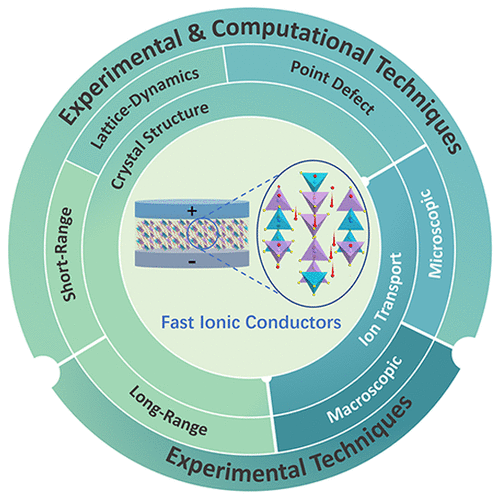当前位置:
X-MOL 学术
›
Chem. Rev.
›
论文详情
Our official English website, www.x-mol.net, welcomes your feedback! (Note: you will need to create a separate account there.)
Classical and Emerging Characterization Techniques for Investigation of Ion Transport Mechanisms in Crystalline Fast Ionic Conductors.
Chemical Reviews ( IF 62.1 ) Pub Date : 2020-04-29 , DOI: 10.1021/acs.chemrev.9b00747 Yirong Gao 1 , Adelaide M Nolan 2 , Peng Du 1 , Yifan Wu 1 , Chao Yang 1 , Qianli Chen 1 , Yifei Mo 2, 3 , Shou-Hang Bo 1
Chemical Reviews ( IF 62.1 ) Pub Date : 2020-04-29 , DOI: 10.1021/acs.chemrev.9b00747 Yirong Gao 1 , Adelaide M Nolan 2 , Peng Du 1 , Yifan Wu 1 , Chao Yang 1 , Qianli Chen 1 , Yifei Mo 2, 3 , Shou-Hang Bo 1
Affiliation

|
Ion transport in crystalline fast ionic conductors is a complex physical phenomenon. Certain ionic species (e.g., Ag+, Cu+, Li+, F–, O2–, H+) in a solid crystalline framework can move as fast as in liquids. This property, although only observed in a limited number of materials, is a key enabler for a broad range of technologies, including batteries, fuel cells, and sensors. However, the mechanisms of ion transport in the crystal lattice of fast ionic conductors are still not fully understood despite the substantial progress achieved in the last 40 years, partly because of the wide range of length and time scales involved in the complex migration processes of ions in solids. Without a comprehensive understanding of these ion transport mechanisms, the rational design of new fast ionic conductors is not possible. In this review, we cover classical and emerging characterization techniques (both experimental and computational) that can be used to investigate ion transport processes in bulk crystalline inorganic materials which exhibit predominant ion conduction (i.e., negligible electronic conductivity) with a primary focus on literature published after 2000 and critically assess their strengths and limitations. Together with an overview of recent understanding, we highlight the need for a combined experimental and computational approach to study ion transport in solids of desired time and length scales and for precise measurements of physical parameters related to ion transport.
中文翻译:

研究晶体快速离子导体中离子传输机理的经典和新兴的表征技术。
晶体快速离子导体中的离子传输是一个复杂的物理现象。某些离子种类(例如,Ag +,Cu +,Li +,F –,O 2–,H +)在固体晶体框架中的移动速度与在液体中一样快。尽管仅在有限数量的材料中观察到此特性,但它是包括电池,燃料电池和传感器在内的广泛技术的关键推动力。然而,尽管在过去的40年中取得了长足的进步,但快速离子导体在晶格中的离子迁移机理仍未得到充分理解,部分原因是离子的复杂迁移过程涉及各种长度和时间尺度在固体中。如果没有对这些离子传输机制的全面理解,就不可能合理设计新的快速离子导体。在这篇评论中 我们涵盖了经典的和新兴的表征技术(实验性和计算性),这些技术可用于研究具有主要离子传导性(即电导率可忽略不计)的块状结晶无机材料中的离子传输过程,主要侧重于2000年以后发表的文献,评估其优势和局限性。结合最近的理解概述,我们强调需要一种组合的实验和计算方法来研究所需时间和长度尺度的固体中的离子迁移,并精确测量与离子迁移相关的物理参数。电子传导率可忽略不计),主要侧重于2000年以后发表的文献,并严格评估其优势和局限性。结合最近的理解概述,我们强调需要一种组合的实验和计算方法来研究所需时间和长度尺度的固体中的离子迁移,并精确测量与离子迁移相关的物理参数。电子传导率可忽略不计),主要侧重于2000年以后发表的文献,并严格评估其优势和局限性。结合最近的理解概述,我们强调需要一种组合的实验和计算方法来研究所需时间和长度尺度的固体中的离子迁移,并精确测量与离子迁移相关的物理参数。
更新日期:2020-07-08
中文翻译:

研究晶体快速离子导体中离子传输机理的经典和新兴的表征技术。
晶体快速离子导体中的离子传输是一个复杂的物理现象。某些离子种类(例如,Ag +,Cu +,Li +,F –,O 2–,H +)在固体晶体框架中的移动速度与在液体中一样快。尽管仅在有限数量的材料中观察到此特性,但它是包括电池,燃料电池和传感器在内的广泛技术的关键推动力。然而,尽管在过去的40年中取得了长足的进步,但快速离子导体在晶格中的离子迁移机理仍未得到充分理解,部分原因是离子的复杂迁移过程涉及各种长度和时间尺度在固体中。如果没有对这些离子传输机制的全面理解,就不可能合理设计新的快速离子导体。在这篇评论中 我们涵盖了经典的和新兴的表征技术(实验性和计算性),这些技术可用于研究具有主要离子传导性(即电导率可忽略不计)的块状结晶无机材料中的离子传输过程,主要侧重于2000年以后发表的文献,评估其优势和局限性。结合最近的理解概述,我们强调需要一种组合的实验和计算方法来研究所需时间和长度尺度的固体中的离子迁移,并精确测量与离子迁移相关的物理参数。电子传导率可忽略不计),主要侧重于2000年以后发表的文献,并严格评估其优势和局限性。结合最近的理解概述,我们强调需要一种组合的实验和计算方法来研究所需时间和长度尺度的固体中的离子迁移,并精确测量与离子迁移相关的物理参数。电子传导率可忽略不计),主要侧重于2000年以后发表的文献,并严格评估其优势和局限性。结合最近的理解概述,我们强调需要一种组合的实验和计算方法来研究所需时间和长度尺度的固体中的离子迁移,并精确测量与离子迁移相关的物理参数。


























 京公网安备 11010802027423号
京公网安备 11010802027423号